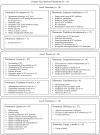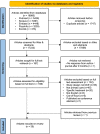Conjoint analyses of patients' preferences for primary care: a systematic review
- PMID: 36085032
- PMCID: PMC9463739
- DOI: 10.1186/s12875-022-01822-8
Conjoint analyses of patients' preferences for primary care: a systematic review
Abstract
Background: While patients' preferences in primary care have been examined in numerous conjoint analyses, there has been little systematic effort to synthesise the findings. This review aimed to identify, to organise and to assess the strength of evidence for the attributes and factors associated with preference heterogeneity in conjoint analyses for primary care outpatient visits.
Methods: We searched five bibliographic databases (PubMed, Embase, PsycINFO, Econlit and Scopus) from inception until 15 December 2021, complemented by hand-searching. We included conjoint analyses for primary care outpatient visits. Two reviewers independently screened papers for inclusion and assessed the quality of all included studies using the checklist by ISPOR Task Force for Conjoint Analysis. We categorized the attributes of primary care based on Primary Care Monitoring System framework and factors based on Andersen's Behavioural Model of Health Services Use. We then assessed the strength of evidence and direction of preference for the attributes of primary care, and factors affecting preference heterogeneity based on study quality and consistency in findings.
Results: Of 35 included studies, most (82.4%) were performed in high-income countries. Each study examined 3-8 attributes, mainly identified through literature reviews (n = 25). Only six examined visits for chronic conditions, with the rest on acute or non-specific / other conditions. Process attributes were more commonly examined than structure or outcome attributes. The three most commonly examined attributes were waiting time for appointment, out-of-pocket costs and ability to choose the providers they see. We identified 24/58 attributes with strong or moderate evidence of association with primary care uptake (e.g., various waiting times, out-of-pocket costs) and 4/43 factors with strong evidence of affecting preference heterogeneity (e.g., age, gender).
Conclusions: We found 35 conjoint analyses examining 58 attributes of primary care and 43 factors that potentially affect the preference of these attributes. The attributes and factors, stratified into evidence levels based on study quality and consistency, can guide the design of research or policies to improve patients' uptake of primary care. We recommend future conjoint analyses to specify the types of visits and to define their attributes clearly, to facilitate consistent understanding among respondents and the design of interventions targeting them. Word Count: 346/350 words.
Trial registration: On Open Science Framework: https://osf.io/m7ts9.
Keywords: Attributes; Conjoint analysis; Discrete choice experiments; Patients; Preference; Preference heterogeneity; Primary care; Systematic review.
© 2022. The Author(s).
Conflict of interest statement
The authors declare that they have no competing interests.
Figures
References
-
- International Conference on Primary Health Care, World Health Organization, United Nations Children's Fund. Primary health care: Report of the International Conference on Primary Health Care, Alma-Ata, USSR, 6–12 September 1978 / Jointly Sponsored by the World Health Organization and the United Nations Children's Fund. Geneva: World Health Organization; 1978. Report No.: 9241800011.
-
- Organisation for Economic Co-operation and Development. Primary Care. 2022. [cited 2022 26 May]. Available from: https://www.oecd.org/health/primary-care.htm.
-
- World Health Organization. Primary health care. 2021. [cited 2022 26 May]. Available from: https://www.who.int/health-topics/primary-health-care#tab=tab_1.
Publication types
MeSH terms
LinkOut - more resources
Full Text Sources



